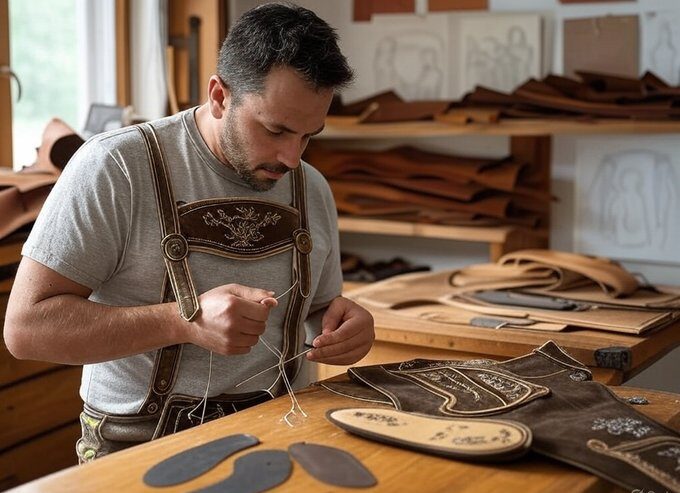
Blog
How to Make Lederhosen? A Complete Step-by-Step Guide

How to Make Lederhosen?
Curious about how to make Lederhosen from scratch? This guide breaks down each step of the process so you can confidently craft your own traditional Bavarian garment. From choosing the right leather to adding those classic embroidered suspenders, every detail counts. Whether you’re passionate about DIY fashion or preserving cultural craftsmanship, this tutorial gives you the tools to succeed. Let’s dive into the art of Lederhosen-making, where tradition meets hands-on creativity.
How to Measure for Lederhosen
Skill Level and Time Commitment Required?
Creating authentic Lederhosen is a rewarding but demanding project that requires more than just basic sewing experience. It’s not ideal for beginners, as working with leather introduces unique challenges—such as thick, non-stretch fabric and specialized stitching techniques. Intermediate to advanced sewing or leatherworking skills are often necessary, particularly if you want your pair to be both functional and true to Bavarian tradition. Expect to invest a considerable amount of time, especially if you’re doing this solo and aiming for precision in both fit and finish. Those new to garment making may want to consider a test run using muslin or faux leather to practice cutting, piecing, and assembling before tackling the real hide. Understanding the time and skill investment early helps ensure your Lederhosen-making journey is enjoyable and yields results you can proudly wear or display.

Essential Materials and Tools You’ll Need
To create a traditional, durable, and comfortable pair of Lederhosen, gathering the right materials and tools is essential. Start with high-quality leather—preferably genuine suede or deerskin—as these provide the signature rugged look and pliability needed for proper shaping and wear. You’ll also need strong, durable thread that can withstand stress, along with leather-specific needles, either for hand stitching or a heavy-duty sewing machine. Other must-haves include rivets, buckles, and sturdy buttons, which are integral to fastening and reinforcing the structure of the garment.
For precise cutting, invest in sharp rotary cutters or heavy-duty scissors, and use chalk or specialized leather marking pens to trace your patterns without damaging the hide. If you plan to include decorative touches, optional tools like embroidery floss, stamping tools, or leather punches will let you personalize your work with traditional motifs or custom initials. Investing in the right materials and tools from the beginning ensures that your Lederhosen not only look authentic but also last for years to come.

How to Choose or Draft a Lederhosen Pattern
If you’re new to sewing leather garments, starting with a pre-printed Lederhosen pattern is highly recommended—these are often designed specifically for thicker materials and include traditional components like the drop-front flap, reinforced seat, and buttoned leg hems. More advanced makers may prefer modifying a basic trouser pattern by incorporating classic Lederhosen features such as the split waistband, side seams, and decorative leg cuffs. Make sure your pattern includes clear markings for suspender attachment points and accommodates the leather’s limited stretch. Pay special attention to seam placement and gusset shaping, as these determine comfort and mobility. A well-chosen or precisely drafted pattern ensures each element—from structure to fit—aligns with the historical style and functional demands of this iconic garment.

Measuring and Cutting the Leather Properly
Precision during the measuring and cutting phase is absolutely vital when making Lederhosen, as leather is expensive, unforgiving, and doesn’t allow for mistakes easily. Start by accurately measuring your waist, seat, thigh, inseam, and outseam—just as you would when preparing to purchase a pair. Always use a soft measuring tape and record each value with care, as even minor discrepancies can affect the final fit. Once your pattern is ready, lay it out thoughtfully on your leather hide, taking into account the grain direction and any natural variations or imperfections in the material.
Leather stretches slightly over time, but it does not behave like fabric—so aligning your pattern correctly is essential to ensure uniform wear and durability. Use tailor’s chalk or a specialized leather marking pen to trace the pattern lines, then cut along those lines using a rotary cutter or sharp precision blade. Smooth, steady cuts make assembly cleaner and reduce the chance of ragged edges or uneven seams. This stage sets the tone for the rest of the build, so take your time to cut accurately and confidently.

Sewing and Assembling the Main Body
Sewing and assembling the main body of your Lederhosen is where craftsmanship truly comes into play, as leather requires both the right tools and a deliberate technique. Begin by stitching the front and back leg pieces together, aligning your seams precisely to avoid puckering or uneven bulk. Next, insert the gusset at the crotch area—this not only enhances comfort and mobility but also reflects the traditional construction style of Bavarian garments.
For the iconic flap-front (also known as the drop-front), carefully align the panel before stitching, ensuring it opens and closes cleanly. Since leather is thicker and less forgiving than fabric, use a heavy-duty sewing machine with leather needles and thick polyester or nylon thread, or opt for hand-stitching with an awl and saddle-stitch technique. Throughout the process, reinforce high-stress zones like the seat and crotch with additional stitching or leather patches to prevent tearing during wear. Always flatten seams using a mallet or seam roller for a smooth, finished interior. This stage forms the backbone of your Lederhosen—so every seam should combine structural integrity with traditional authenticity.
History of Lederhosen

Adding Suspenders and Decorative Details
Adding suspenders and decorative details is where your Lederhosen starts to take on a truly traditional and personalized Bavarian character. Begin by crafting the suspenders, typically in the classic “H-style” with a horizontal embroidered chest strap that connects two vertical bands. Use the same leather as your main garment or a slightly thinner version for flexibility. Reinforce the ends with double layers and add buttonholes or buckles for adjustable length.
For decoration, consider embroidering classic Alpine motifs—such as edelweiss flowers, deer, or oak leaves—using thick embroidery floss or leather paint. Colored piping along the seams or leg cuffs can also elevate the look and add a touch of contrast. Personalized initials or family crests stitched onto the chest strap are a cherished tradition in some regions. When attaching the suspenders, carefully align and sew or rivet the buttons to the waistband to ensure balanced support. These final touches not only enhance visual appeal but also celebrate the rich cultural symbolism of Lederhosen craftsmanship.

Fitting and Final Adjustments
Fitting and final adjustments are crucial to transforming your handmade Lederhosen from a raw project into a wearable, polished piece of traditional attire. Begin by trying on the Lederhosen in a standing and seated position to assess the fit around your waist, seat, and thighs. The leather should feel snug but not restrictive—remember, it will loosen slightly over time. Check that the rise aligns comfortably at the waist and that the flap front lays flat without gaping. If needed, trim or resew the inseam or outseam for a more precise length. Adjustments might also be necessary around the waistband or gusset area to ensure optimal comfort and movement. Once the fit feels right, apply finishing touches like sealing the raw leather edges with wax or edge paint to prevent fraying. Conditioning the leather with a quality balm not only softens it but also prepares it for long-term use. These final steps guarantee that your Lederhosen looks as impressive as it feels.
Where to buy lederhosen?
Care Tips for Handmade Lederhosen
Caring for your handmade Lederhosen properly ensures their longevity, beauty, and functionality for years to come. Since they’re made from real leather—often suede or deerskin—they require special attention that differs from standard clothing care. After each wear, allow the Lederhosen to air out in a cool, shaded space to prevent moisture build up and odor.
For minor stains or dirt, gently spot clean with a damp cloth and avoid using harsh soaps or soaking them in water, which can damage the leather. Never place Lederhosen in a washing machine or dryer, as this can warp the structure and strip the natural oils. Instead, invest in a high-quality leather balm or conditioner to nourish the material and maintain its flexibility. Store them flat or on a wide hanger in a breathable garment bag to avoid creasing or mildew. With consistent, gentle care, your handmade Lederhosen will age gracefully—developing a rich patina that tells the story of every celebration and season.

Anna Bauer is a seasoned Bavarian fashion expert, cultural consultant, and heritage stylist with over a decade of hands-on experience in traditional German clothing. Born in Munich, the heart of Bavaria, Anna grew up surrounded by the rich traditions of Trachten fashion. Her passion for cultural attire led her to pursue a degree in Fashion and Textile Design at the prestigious University of the Arts Berlin, where she specialized in European folkwear.
Over the past 12+ years, Anna has collaborated with renowned Trachten designers, styled outfits for Oktoberfest events across Germany, and contributed articles to top fashion and culture magazines across Europe. Her work focuses on preserving the authenticity of Lederhosen and Dirndl wear while helping modern audiences style them with confidence and flair.
As the lead content contributor for German Attire, Anna combines her academic background, professional styling experience, and deep cultural roots to provide readers with valuable insights into traditional German fashion. Her blog posts cover everything from historical origins and styling guides to care tips and festival outfit planning—making her a trusted voice for anyone looking to embrace Bavarian heritage in a stylish, modern way.
